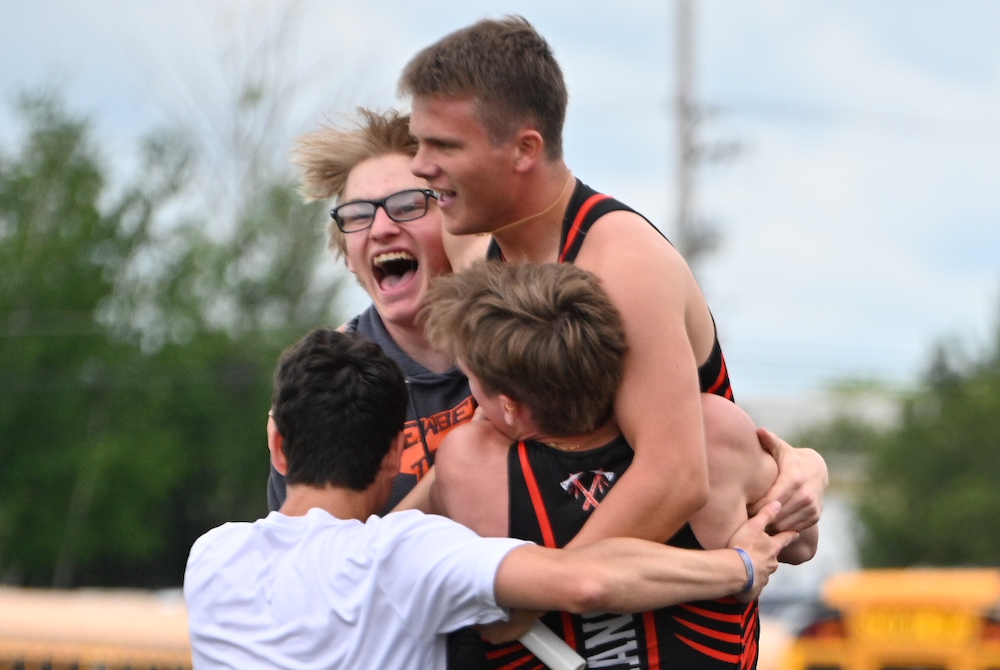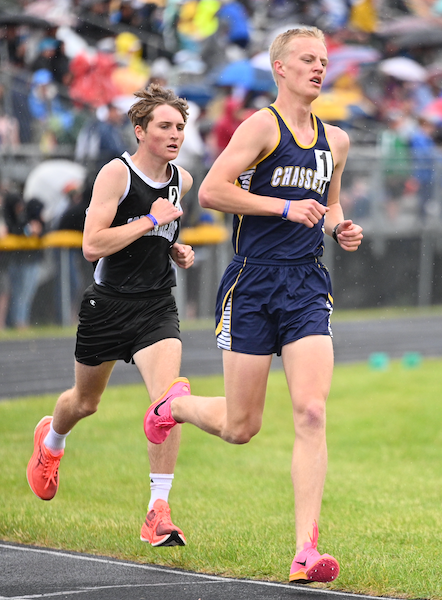
Casting Lines for Future Tournaments
August 12, 2016
By Jack Roberts
MHSAA Executive Director
The MHSAA is best known to the public for the tournaments it conducts to conclude the fall, winter and spring seasons each school year.
These tournaments, the first and largest program of the MHSAA, have survived the Vietnam War, the Korean conflict and two World Wars. They have survived the technology bubble, the housing collapse, the energy crisis and the Great Depression.
MHSAA tournaments existed at the dawn of aviation and at the time of our nation’s lunar landing. Popes, presidents and governors have changed and changed again and again, and MHSAA tournaments roll on year after year.
But the sense of tradition and permanence and inevitability of MHSAA tournaments doesn’t dissuade us from asking questions about our tournaments, even some of the most basic questions. Here are two.
Question #1
I have long been and will always be an advocate for a Ryder Cup format for the MHSAA Golf Finals, and a team tennis approach to the MHSAA Tennis Finals; but 90 years of tradition is hard to overcome. Might this be a more exciting format? Could it be co-ed? Could it reverse the decline in boys tennis participation, and increase girls golf participation? Wouldn’t it be fun to try?
Periodically, the International Olympic Committee requires each of the designated Olympic sports to defend its status, to state its case why the sport should remain a part of the Olympic program. Then, after a series or votes that retain one sport at a time, the IOC drops the sport that makes the weakest case. It does so to make room for one of the previously unlisted sports that makes the best case for inclusion.
This would appear to keep the existing Olympic sports on their toes, and to keep the Olympic movement fresh and reflective of modern trends in sports.
While I would not enjoy the controversy, I can see the potential for some positive results if the MHSAA were to invoke the same policy for determining the 14 tournaments it will provide for girls and the 14 for boys.
This might cause us to consider more deeply what a high school sport should look like, or at least what an MHSAA tournament sport should stand for.
On the one hand, we might be inclined to drop tournaments for those sports that involve mostly non-faculty coaches and non-school venues, or require cooperative programs to generate enough participants to support a team, or resort almost entirely to non-school funding, or cater to individuals more than teams.
Or perhaps this process would cause policymakers to forget traditional thinking and ask: “In this day and age, should we shake off traditional notions of sport and consider more where modern kids are coming from?” That might mean fewer team sports and more individual sports, more “extreme” sports like snowboarding and skateboarding, and more lifetime sports, meaning not just golf and tennis and running sports, but also fishing and even shooting sports.
Currently, MHSAA policy states that the MHSAA will consider sponsorship of a tournament series for any sport which 64 member schools conduct on an interscholastic basis as a result of action by the governing boards of those schools.
Should the only question be how many schools sponsor a sport, or must an activity also have certain qualities and/or avoid certain “defects?” What should an MHSAA tournament sport look like and stand for?
Question #2
Bristling from criticism that his association is a money-grabbing exploiter of children, my counterpart in another state said, “If we were running our programs just to make money, we would do very many things very differently.” I knew exactly what he meant.
Because we care about the health and welfare of students, because we mean what we say that the athletic program needs to maximize the ways it enhances the school experience while minimizing academic conflicts, and because we try to model our claim that no sport is a minor sport when it comes to its potential to teach young people life lessons, we operate our programs in ways that make promoters, marketers and business entrepreneurs laugh, cry or cringe.
If money were the only object, we would seed and select sites to assure the teams that attracted the most spectators had the best chance to advance in our tournaments, regardless of the travel for any team or its fan base. If money were the only object, we would never schedule two tournaments to overlap and compete for public attention, much less tolerate three or four overlapping events. If money were the only object, we would allow signage like NASCAR events and promotions like minor league baseball games.
Those approaches to event sponsorship may not be all wrong; they’re just not all right for us. And we will live with the consequences of our belief system.
During a typical school year, more than 20 percent of the MHSAA’s 2,097 District, Regional and Final tournaments lose money. Not a single site in golf, skiing or tennis makes a single penny. In no sport did every District, Regional and Final site have revenue in excess of direct expenses.
In fact, in only three sports – boys and girls basketball and football – is revenue so much greater than direct expenses overall that it helps to pay for all the other tournaments in which the MHSAA invests.
That’s right: invests. When we present our budget to our board, we talk about the MHSAA’s investment in providing tournament opportunities in all those sports and all those places that cannot sustain the cost of those events on their own. How much is this investment worth to students, schools and society?
These two are core questions that require our focus far in advance of talk about scheduling, site selection, seeding and the myriad matters that too often hijack our time and attention.

With 2nd Place in Final Race, Newberry Clinches 1st in Final Team Standings
By
John Vrancic
Special for MHSAA.com
June 2, 2024
KINGSFORD — The race for the Upper Peninsula Division 3 boys track & field championship came right down to the wire Saturday as Newberry edged St. Ignace 96-92 for top honors.
Third-place team finisher Lake Linden-Hubbell won the day’s final race, the 1,600-meter relay, in 3 minutes, 41.94 seconds, and Newberry hung on to edge St. Ignace by two steps for second place and its first title in eight years.
Newberry, which was runner-up to Munising last year, was clocked at 3:43.07 in the 1,600 relay on this sunny and mild late afternoon. The Saints finished nine hundredths of a second later.
“We knew we had to beat St. Ignace to win,” Newberry senior Kennedy Depew said after finishing the anchor leg. “This was my last race ever. I knew I had to give it my all. That’s also why I knew I had to scratch from the open 400. I would have been in four events. I think scratching from the 400 helped me save some energy. We weren’t satisfied with runner-up last year, which makes this year’s championship all the more satisfying.”
Classmate Gabe Luck provided Newberry with its lone individual first with a heave of 44 feet, 1¾ inches in shot put.
“We had a lot of injuries this year,” Newberry coach Drew Schultz said. “For all the obstacles we had, we wouldn’t have it any other way, having two of the best athletes decide it in the last race. I’m extremely proud of our guys. To win it that way is just insane. I’m proud of all our eastern-end kids.”
 Depew also was runner-up in the 100-meter dash in 11.63 seconds.
Depew also was runner-up in the 100-meter dash in 11.63 seconds.
Senior Jon Ingalls, who ran the last leg for the Saints, won the 110 hurdles (16.39) and 300s (42.89) and helped them place second in the 400 relay (45.94).
“Both hurdles were decent,” Ingalls said. “Those weren’t my best times, but it feels good to grind out a few more wins.”
Senior Owen Lester also provided the Saints with a victory in pole vault (12-6).
LL-H got firsts from senior Gabe Popko in discus at 153 feet, 4¼ inches, and classmate Matt Jokela in the 400 (51.09). Jokela also took third in the 100 (11.65).
“Real good hydration and confidence are keys,” Jokela said. “I think having confidence helps a little. I usually don’t go too hard out of the blocks. Then, I usually try to go as hard as I can in the last 200.”
Chassell junior Kalvin Kytta claimed three firsts, taking the 800 in a personal-best 2:03.62, 1,600 (4:39.58) and 3,200 (10:27.32).
“Three wins, I’m pretty happy with that,” he said. “The 800 went real well. Overall, I’m very happy with my performance today.”
Fourth-place Bessemer set UPD3 Finals records in the 400 relay (45.3) and 800 (1:34.64). Powers North Central previously set the record in the 400 (45.34) two years ago and Rock Mid Peninsula had held the 800 record since 2001 when it ran a 1:35.1.
“We shaved two seconds off in the 800 relay which feels good, and our handoffs in the 400 were good all year,” Bessemer senior Landon Peterson said. “Our school record in the 400 is 44.98, which is something we’ve done three times this year. Running on a rubber track gives you a much better grip, which helped us a lot today.”
Bessemer senior Tom Trudgeon became a four-event winner, also taking the 100 (11.46) and 200 (23.85).
Crystal Falls Forest Park freshman Vic Guiliani won high jump (6-0), and sophomore Michael Rexford went 19-9 in long jump, providing Escanaba Holy Name with its first U.P. Finals title since the school reopened in 2021.
PHOTOS (Top) Newberry runners celebrate taking second place in the 1,600 relay, allowing them to finish ahead of St. Ignace for the team title in Upper Peninsula Division 3. (Middle) Chassell's Kalvin Kytta and Cedarville/DeTour's Ethan Snyder lead the pack of 1,600 runners. (Click for more from Cara Kamps/RunMichigan.com.)

